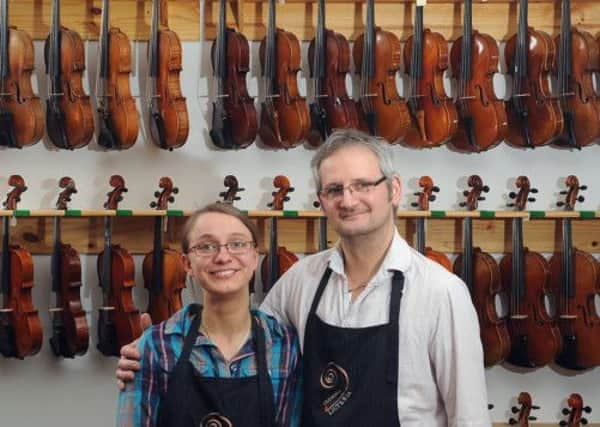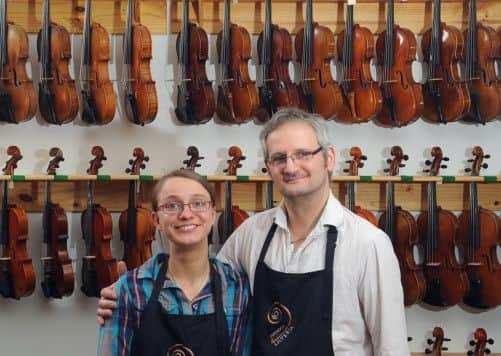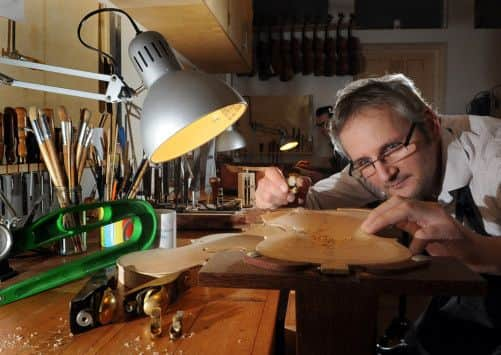Fine tuning their craft


Joerg Koplin holds up to the light the front part of a violin he is making and it’s translucent, like a living membrane.
He taps one side with his index finger and listens. Tiny vibrations indicate that the piece of spruce he selected for this job has the correct density and is fit for purpose. It’s hard to believe that something as delicate could have come from something as crude as a lump of wood.
Advertisement
Hide AdAdvertisement
Hide AdStacked on the workshop shelves are mute blanks of seasoned maple and spruce which have all been selected to sing as stringed instruments. A single piece of raw material may cost £1,000 and a completed cello £12,000.


As you step through the front door of their home on a bitterly cold morning there’s a slightly tropical feeling. In the middle of the floor a humidifier is puffing vigorously surrounded by ranks of violins, cellos and basses. How much moisture and warmth do they need? “If you are feeling comfy, so are they,” says Joerg.
They also like a bit of a tan. In Italy the tradition was to hang newly-made violins outside in the sun for the white wood to acquire a brown tinge prior to finishing.
York being mostly a sun-free zone, the Koplins made a special version of a UV tanning studio for the instruments. Creating them clearly involves quite a bit of emotional investment on the part of Joerg and his wife Steffi who are both hard at work in matching dark blue aprons marked Cremona Liuteria.
Advertisement
Hide AdAdvertisement
Hide AdJoerg, 47, was born in Anklam near the Baltic coast in the former republic of East Germany. He recalls growing up in a Communist country where if you wanted something doing you had to do it yourself. The GDR system was not much good at consumer products, especially cars, and Joerg recalls the engineering inventiveness required of his father and himself to keep a succession of dodgy family motors on the road.


These early experiences made him adaptable. He started out as an apprentice technician in telecommunications, an industry for the modern world, and has ended up in one which employs methods largely perfected centuries ago. He initially left telecoms behind in order to pursue his passion for woodworking and started a successful business in East Berlin in 1993 making and laying parquet and hardwood floors.
He had never played a note or held a stringed instrument when he met Steffi, a Berlin girl who was already a violin maker.
“I couldn’t see myself working on a building site or on the floors at 50 or 60,” he says. “So I thought maybe this is a way of doing something else.”
Advertisement
Hide AdAdvertisement
Hide AdIn all respects he was right. They fell in love and got married, although they are now so busy in this combined home and workshop in York that they can’t remember what year it was. But by then the Berlin Wall was down and the unified city was the new focus of Europe and full of cultural opportunities. So why leave?
“Coming from Berlin, I couldn’t think of living anywhere else in Germany,” says 33 year-old Steffi. “But it is packed with violin makers. They just don’t need us.”
The East Germany in which she grew up may not have been so hot at cars but it could be excellent at education. Steffi started playing the violin at seven and was selected for a special school for talented musicians.
“We had extra lessons for string instruments and piano, it was a really good system,” she says. “There was no time for anything else. I worked from seven in the morning to eight at night. I really enjoyed it. I was 12 when I did my first work experience with a violin maker. I still have the diary in which I wrote, ‘I have just decided to become a violin maker’.” As she grew older and won prizes for her playing, Steffi became less certain.
Advertisement
Hide AdAdvertisement
Hide Ad“I thought, ‘Am I going to be a player or a maker?’ I saw how tough it was at the Berlin Conservatoire and I thought, ‘gosh, that’s too much’. I had further work experience in a violin shop when I was 18 and decided, ‘That’s it, I am going to be a maker.”
When her schooling finished she went straight to Italy, to Cremona, a city where a local family of luthiers called Amati famously devised the modern version of the violin in the 16th-century. The Amatis were succeeded by an even more stellar name, Antonio Stradivari, and it was to the violin making school of that name that Steffi went for three years.
She came over to this country for the first time for two more years of training at a college in Newark and after a period in Canada and France went back to Berlin which was when she met Joerg. Galvanised into switching careers once again, he signed up at the same Newark college for a three-year course on violin making. He was confident in his skills but it was still a culture shock.
“In the GDR we had English in the schools but it was basic stuff. After school we couldn’t speak English and because we couldn’t travel I forgot everything. In Newark I thought at first, ‘God I feel so stupid’. But I learned by doing. ”
Advertisement
Hide AdAdvertisement
Hide AdTo pay his way he worked in a violin shop in Nottingham and for a floor-making company.” In the meantime, Steffi set up a violin making and repair business in Cambridge. They came to York for a weekend trip and took to the place immediately.
“We really didn’t know what to expect moving here,” says Steffi.
“I was scared that my Cambridge customers wouldn’t come, but they did.” One of them is Sue Monks, the principal cellist of the BBC Symphony Orchestra. She played the cello solo on the Last Night of the Proms on a cello made by Steffi.
The couple’s first place was what the estate agents might call compact. There was no heating in the attic space where they slept and the dining room was also the showroom. So they had to be careful what they ate in case cooking odours permeated the surface of the instruments.
Advertisement
Hide AdAdvertisement
Hide Ad“We didn’t want pizza-flavoured violins,” says Steffi. “It’s hard to find a place where you can live and have a business.”
Last summer they found somewhere nearby, in the middle of a huddle of terrace houses, which had begun life as a dairy in the 1890s and they embarked on converting it themselves.
Steffi concedes that simultaneous house building and violin making can make things edgy at times in the household. “We didn’t really argue,” says Steffi. “It was just tough because it was non-stop work.”
Their major building work has now stopped for the winter but everything done so far is superb, especially the parquet floors. One of Joerg’s many projects is to make a violin “after Amati”, creating a design using not much more than a protractor in the manner of those 16th century makers in Cremona.
Advertisement
Hide AdAdvertisement
Hide AdIt takes about one and a half months to make a Koplin violin, two and a half months for a cello. Their prized wood store – some of it has been seasoning for a quarter of a century – came to them from elderly amateur maker in Rotherham who had to stop because of arthritis.
The ideal wood is slow-grown in the Alps so that the grain is narrow and the wood dense. You can’t hurry anything in this job.
Antonio Stradivari (the top price for one of his violins is £9.8m) would feel at home in this workshop. Apart from the electric band saws there’s no tool he wouldn’t recognise. While Joerg makes instruments from scratch, Steffi concentres on repairs and the couple spend time scouring Yorkshire auctions for likely purchases. A violin bought from an antique dealer for £35 turned out to be French. After the Steffi treatment it was worth £2,500.
She is currently working on a violin made in 1772 by Samuel Thompson in England. “It’s special because it has the original neck, it’s quite rare,” she says.
Advertisement
Hide AdAdvertisement
Hide AdMajor repairs often involve prising off the front of an instrument put in place 200 or more years ago. “It’s a matter of patience, not pressure,” says Steffi. “You just wait until they want to come apart.”
Certain cracks can devalue an instrument’s worth by half. The couple bought another violin cracked in about 30 places for £500, not knowing what it was. Steffi completed the restoration a few months ago and had it valued in London at £35,000.
They have lent it for free to a music student friend at the university so she can use it for her final year recital. It seems to be an altruistic gesture typical of this couple. “It was a labour of love,” says Steffi. “Now I have no time for nice projects, I am working non-stop for the shop.” She does find time to play with the Academy of St Olave’s in York and with a folk trio with a passion for Scottish ballads.
The value of historic violins is on the up because of the demand from Asia and China especially. “They are coming here and buying everything, the demand is huge for fine antique instruments from 1600 to the 1850s,” she says.
Advertisement
Hide AdAdvertisement
Hide AdTo judge whether the Koplins’ move to York was well-judged, just look at an array of post-it notes stuck on the wall. Those beneath the In Arbeit (in progress) category stretches much further than the Fertig (finished) list.
“We have done no advertising, it’s all by word of mouth, and we are up to here with work,” says Steffi.
On a personal level Yorkshire suits them, maybe because they appear to share a certain English quirkiness and a similar sense of humour.
“It’s a lot less stressful,” says Joerg. “People are more kindly and open and more willing to share what they know, such as their varnish recipes.”
Advertisement
Hide AdAdvertisement
Hide AdHe is now reciprocating that welcome by inviting friends and neighbours in for night lessons in violin making, two evenings of five people a week. “Some of them are people who have never used a file but they all have a passion to make their own violin,” says Joerg. “I am so happy to help them.”
Meet the violin makers at yorkshirepost.co.uk/video or watch on our tablet apps. Download a free trial from the Apple, Google or Amazon Kindle app store.